
What will Harvard students do next Spring?
Harvard’s plan for the Spring 2021 semester is finally out. Here’s what your peers are planning on doing.
On December 1, Harvard announced undergraduate residential policies for the Spring 2021 semester. Of the three options for the spring semester proposed in July, the administration chose the option that allows the greatest number of students to return to campus, with instruction remaining entirely online.
In order of the priority that they will receive for housing, Harvard is inviting seniors, juniors who completed the Fall 2020 semester, students with learning environment needs, and students who live in time zones four or more hours distant from EST back to campus. Juniors who were not enrolled in the Fall 2020 semester will be “accommodated to the greatest degree possible”.
Assuming that students’ decisions will be influenced by what their peers do, and the popularity of our Fall 2020 survey, we again sent a survey to the undergraduate population five days after the plan was announced, to give time for the news and initial reactions to settle. We received 792 responses, representing around 12 percent of the undergraduate student body. Here is what we found.
Who will come back to campus?
Not only did we ask students whether they expected to live on campus, but we also asked a series of questions that allowed us to estimate a more precise probability of each respondent returning to campus. These questions asked students to best guess their chances of petitioning, the probability of their petition being accepted, and, if invited, the chance that they would accept that invitation. We multiplied these probabilities together to calculate the probability each student will return to campus, and then applied linearity of expectation to estimate the number of students on campus this spring. Both methods yielded similar results.
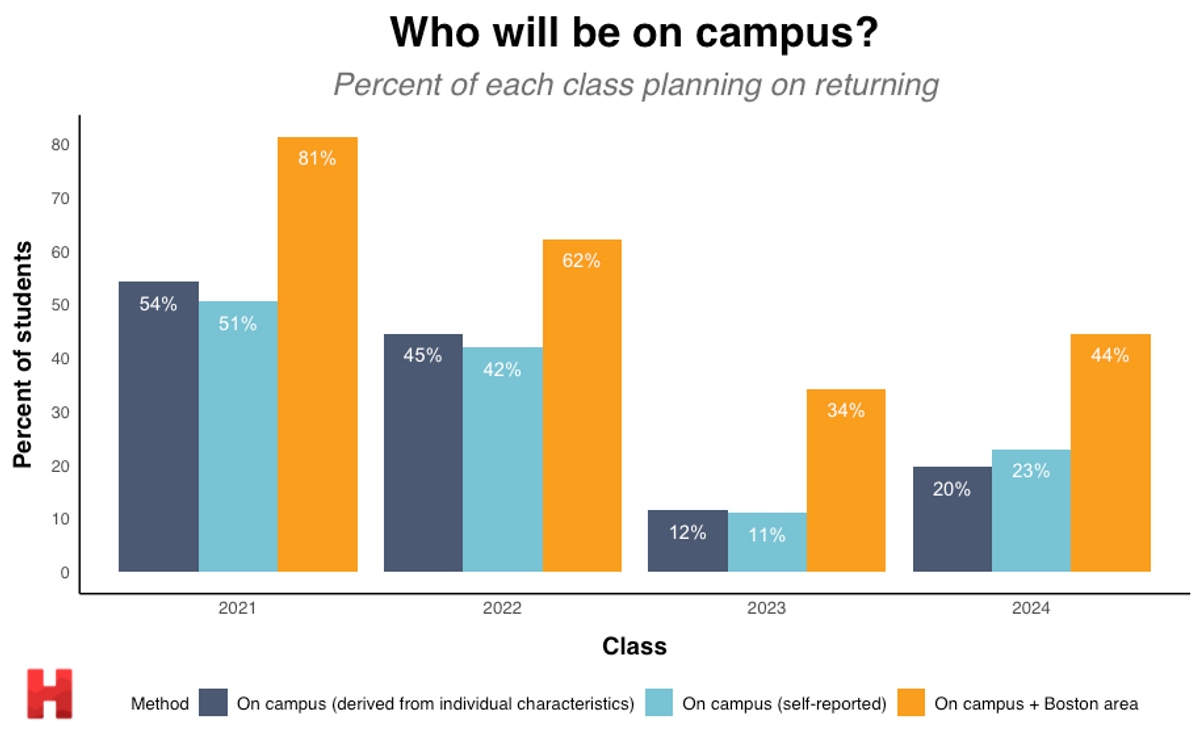
To estimate the fraction of each class that would be living in or near Cambridge, we added the number of students who indicated they would most likely be on campus with those who planned on returning to the Boston area. We found that 81 percent of seniors and 62 percent of juniors currently plan on living around Boston, with just 34 percent of sophomores and 44 percent of freshmen saying the same. The relatively higher rate of freshmen could be because many already were living in Cambridge and thus found it easier to stay nearby.
[A note: since many students have taken leaves of absences, we defined their class year as their “graduation year at matriculation”, i.e. their “social class”. ]
Among those not living in Cambridge, 44 percent of freshmen and 39 percent of sophomores indicated that they were planning on living with family, significantly higher than the 12 percent of seniors and 21 percent of juniors that indicated the same. The total fraction of students living off-campus remained relatively constant across class years, with relatively more sophomores (24 percent) planning on living off-campus outside of the Boston area.
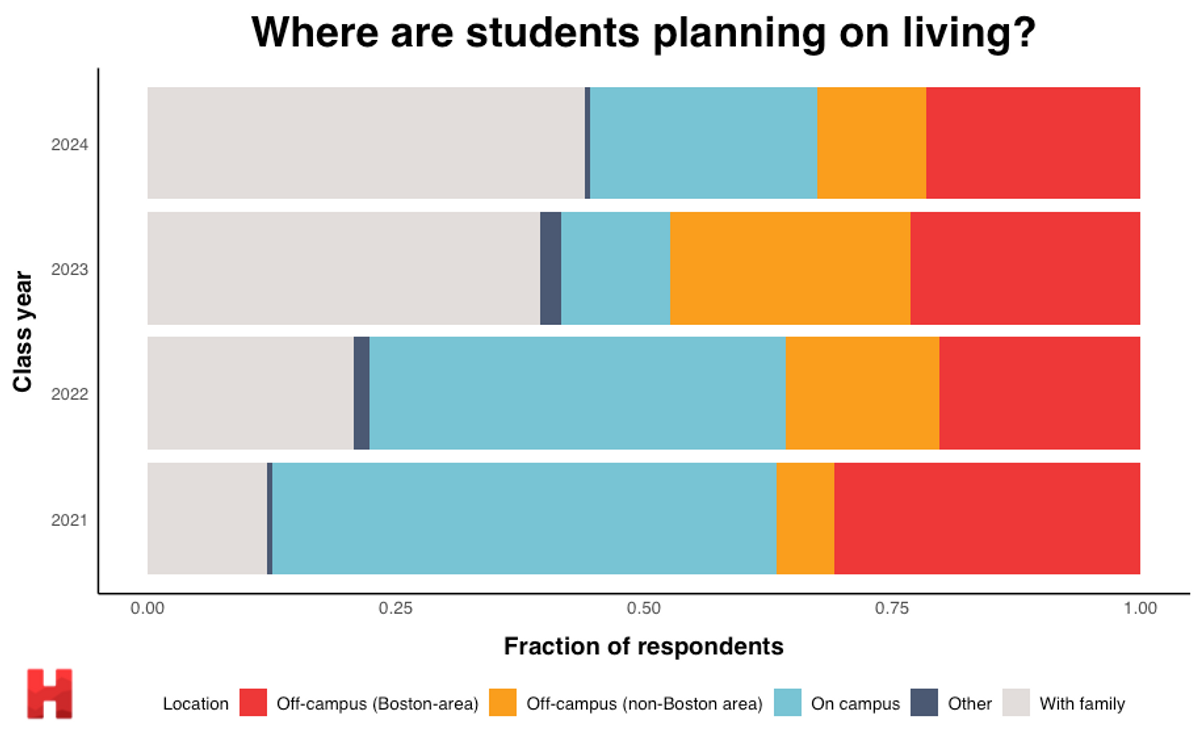
Who will enroll?
Just 77 percent of students enrolled in the Fall 2020 semester. That percentage varied greatly by class, though – nearly 32 percent of the class of 2022 elected to take the fall semester off. We asked students their probability of taking a leave of absence in the Spring semester, regardless of their current enrollment status.
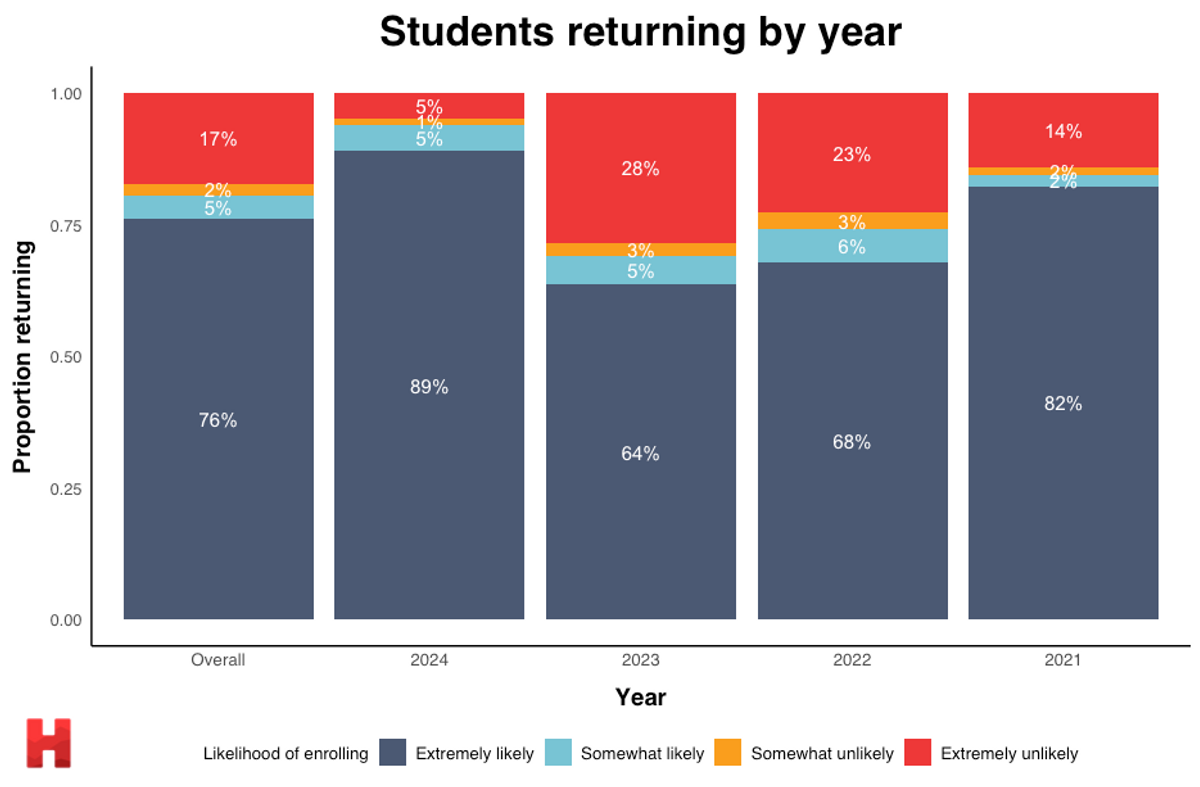
Results differed greatly by class. Few freshmen expect to take time off, and 29 percent of sophomores now indicate that they are “extremely unlikely” to return, the highest percentage of any class.
To get a better estimate of fall enrollment, we conducted a simulation that assumed that 99 percent of “Extremely likely", 75 percent of “Somewhat likely,” 25 percent of “Somewhat unlikely,” and 1 percent of “Extremely unlikely” respondents would enroll in the Spring. This yielded a prediction that 79 percent of students would enroll, an increase from 77 percent last semester.
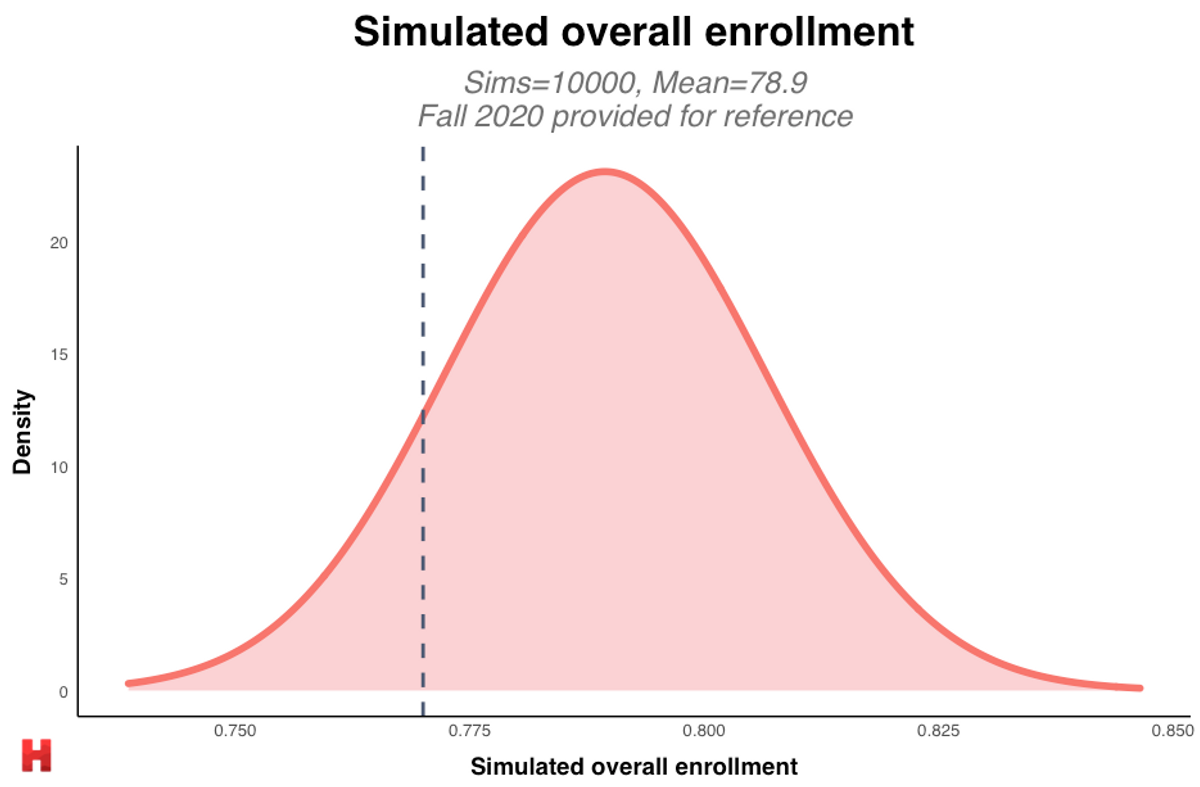
Beyond asking respondents about their individual chances, we asked each respondent for their best guess of spring enrollment, applying what's known as the "wisdom of the crowds." The median prediction was 80 percent, equal to the proportion of students indicating they were either very likely or somewhat likely to enroll after re-weighting for class year. The distribution of predictions is below, with the dashed line representing the (weighted) proportion of respondents who said they were extremely or somewhat likely to enroll:
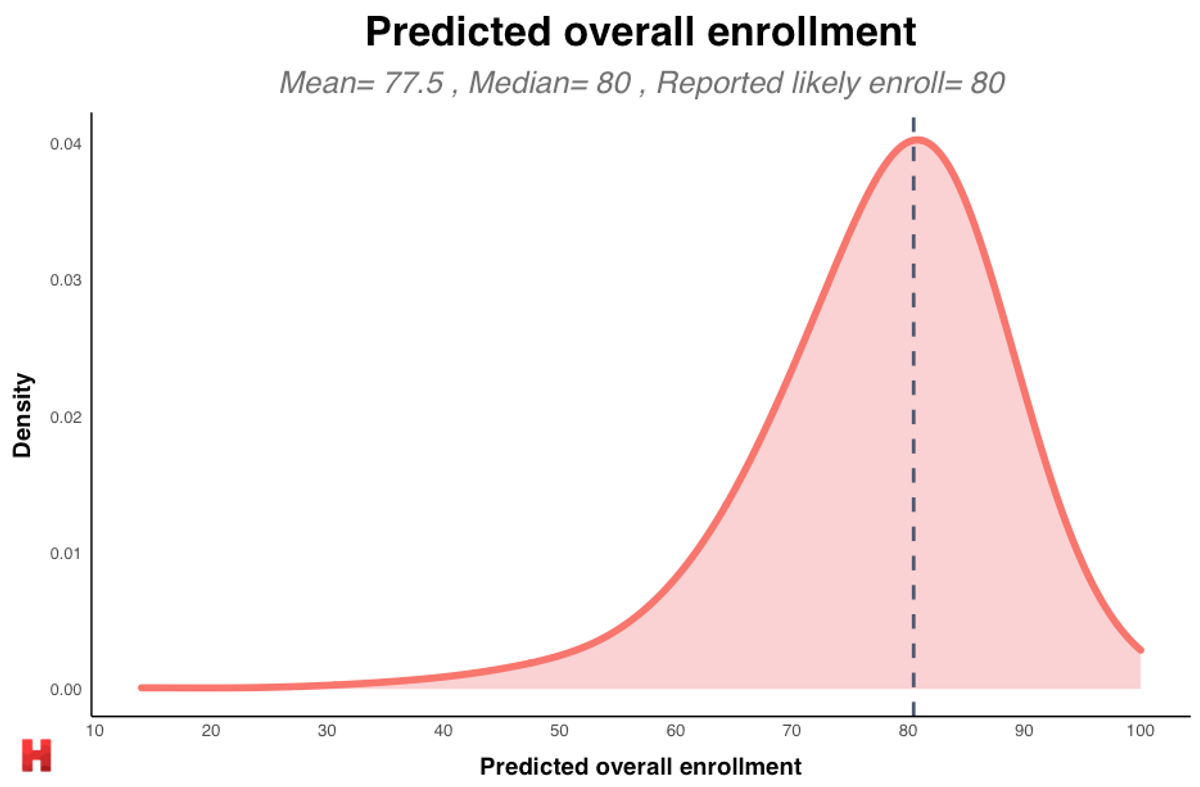
To arrive at enrollment predictions by class year, we also asked respondents how many classmates in their own year they expected would enroll. The Fall 2020 enrollment by class is shown with the dashed lines for reference. Seniors and juniors predicted that a significant proportion of students on leave in their class would return, while sophomores predicted a net decrease in enrollment. By comparison, approximately 20 percent of the class of 2024 chose to defer enrollment this fall.

Building off our analysis in the Fall, we examined the probability of taking time off among international students, those on financial aid, and those who took a leave of absence for the Fall 2020 semester. Only 21 percent of those who took a leave this past fall plan on returning to classes in Spring 2021.

We were also interested in the change in the number of students planning on taking time off by class. We looked at the percentage of students on leave either “somewhat likely” or “very likely” to enroll in the Spring, the percentage of students enrolled who were “somewhat likely” or “very likely” to take a leave of absence, and the net change in enrollment for each class.
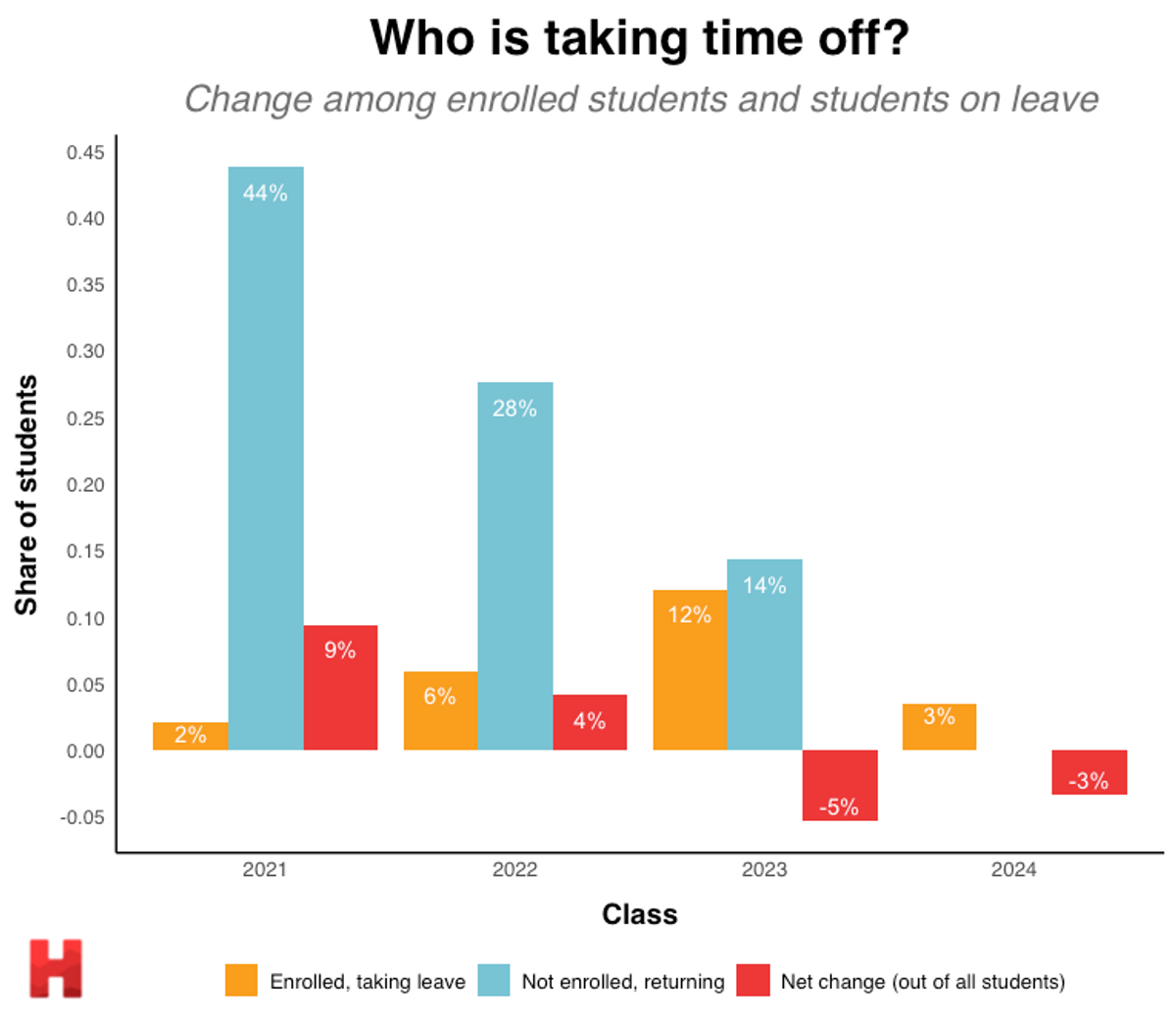
We found that while 44 percent of seniors on leave planned to enroll, only 28 percent of sophomores and 14 percent of juniors planned on doing so. Freshmen and sophomores, however, can expect their enrolled class sizes to shrink by 3 and 5 percent, respectively. Freshmen on leave had to take a full year off, and thus are not eligible to come back in the spring. A word of caution: students on leave who responded to our survey might be more engaged in college life generally, and thus our analysis may overestimate the proportion of returning students in each class.
COVID policies
Harvard’s COVID-19 on campus restrictions were likely a major factor weighing on students’ minds. Harvard defined 5 levels of campus restrictions, each with a different color and set of restrictions: red allows for “essential services only”; orange, “outdoor socializing allowed”; yellow, “one guest in suite, outdoor programming”; lime, “common spaces open”; and green, “all residential spaces open to pre-COVID levels”. 49 percent of respondents predicted that yellow would be in place for the greatest total time.
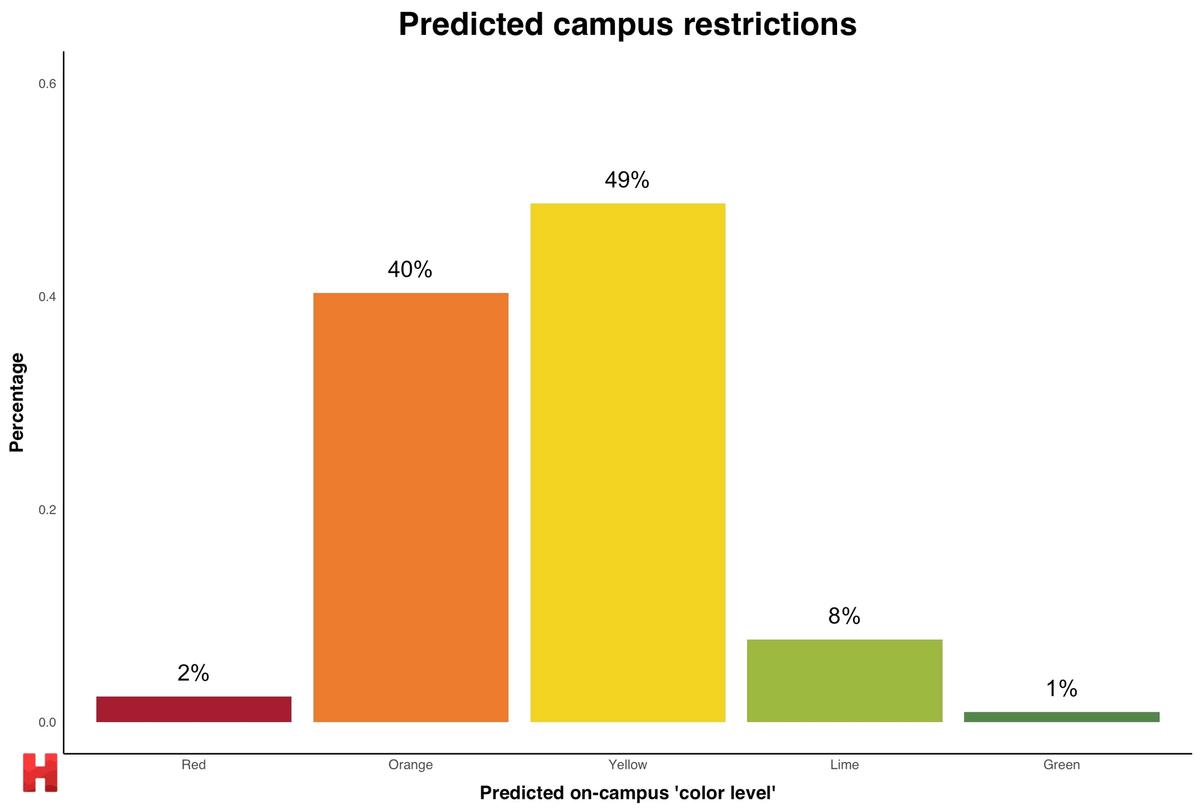
We were also interested in how students' predictions of COVID restrictions on campus influenced their choice to either return to campus or live elsewhere. Predictably, among those eligible to return to campus, a majority of students who predicted on-campus color levels would be “yellow” or “lime” on average elected to return, and a minority among those that predicted “red” or “orange.” Only four students eligible to return to campus predicted that “green” would be most common.
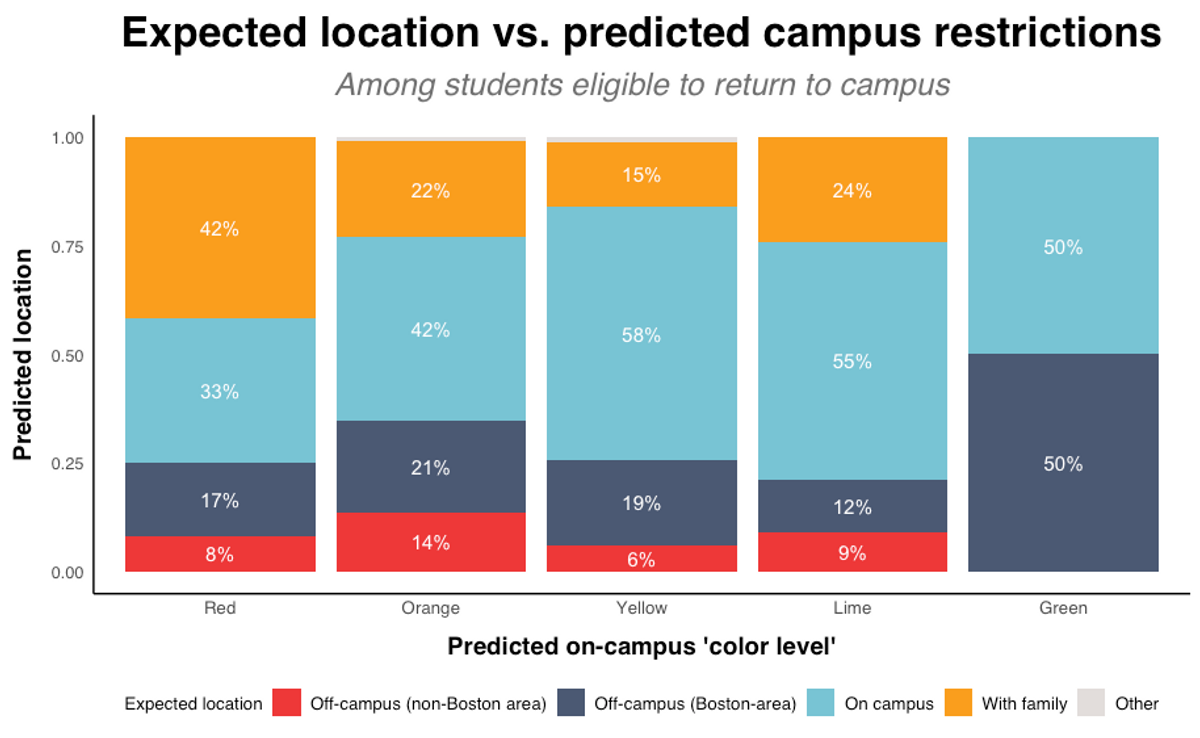
With COVID-19 predictions in mind, however, it is worth noting that student predictions do not have the best track record: in our July survey, students predicted that a median 15 percent of undergraduate students on campus would contract COVID-19. Over the Fall 2020 semester, only 38 total students tested positive, far fewer than what even the administration anticipated during move-in week alone.
Student opinion
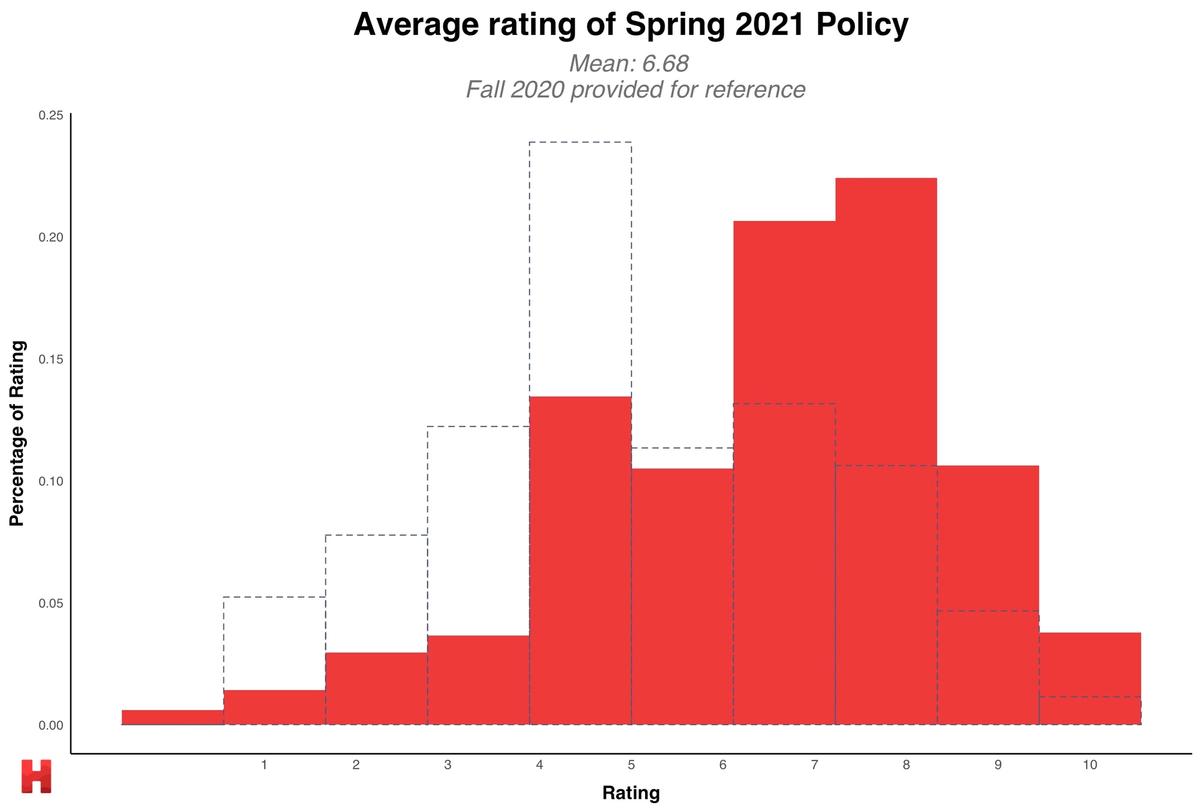
Compared to the favorability of the Fall plan, the Spring plan was slightly more favorable, with a 1.53 point increase. Both seniors and juniors expectedly had above average opinions of the plan, given their priority in next semester’s housing. Sophomores, slated to spend the full academic year remotely, expressed the lowest approval.
Worth noting is how students on financial aid rated the policy, given the majority opinion from our last survey that Harvard’s remote room-board allowance of $5,000 proved insufficient for those living off-campus. Indeed, a plurality (45 percent) of students on financial aid surveyed believe the allowance did not provide enough money to live away from family or off-campus, while roughly a quarter each believed the policy was sufficient or not individualized enough.
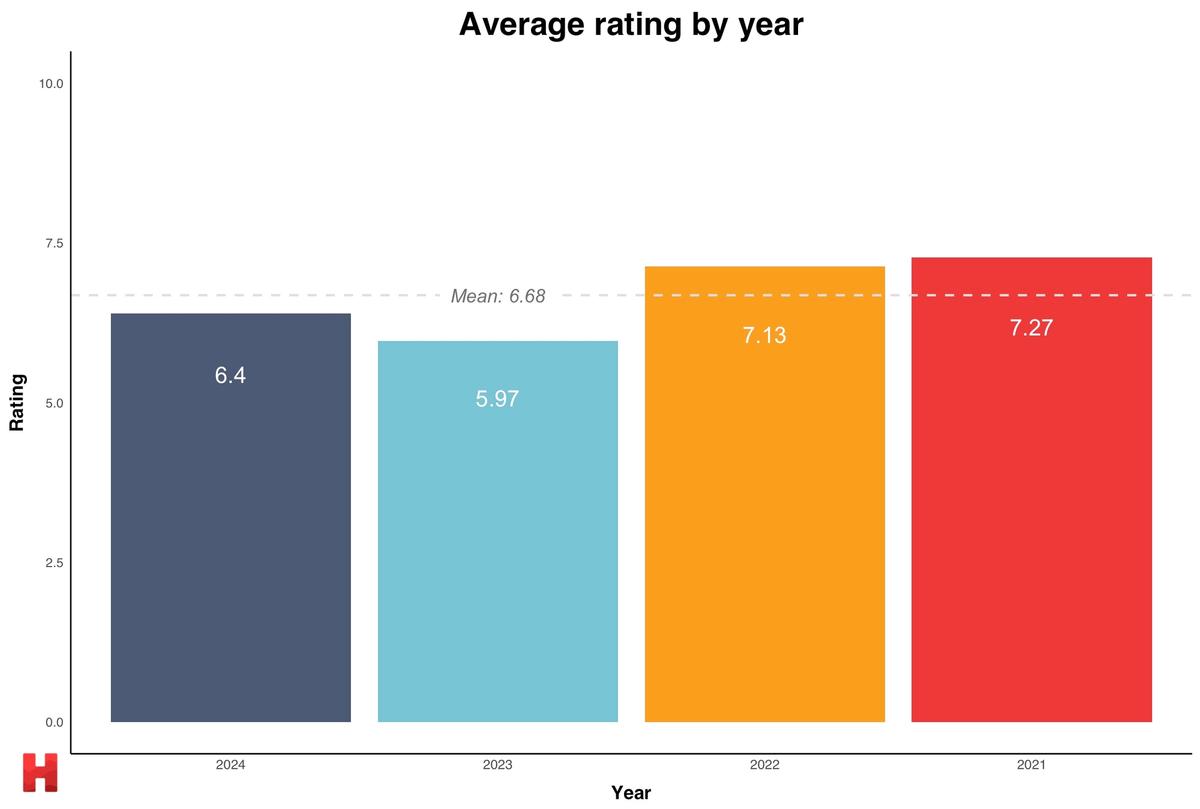
When asked whether they thought a sufficient number of students were allowed back on campus, 65% of all respondents said the number was “just right,” whereas nearly one third of both freshmen and sophomores thought that there would be “too few students.”
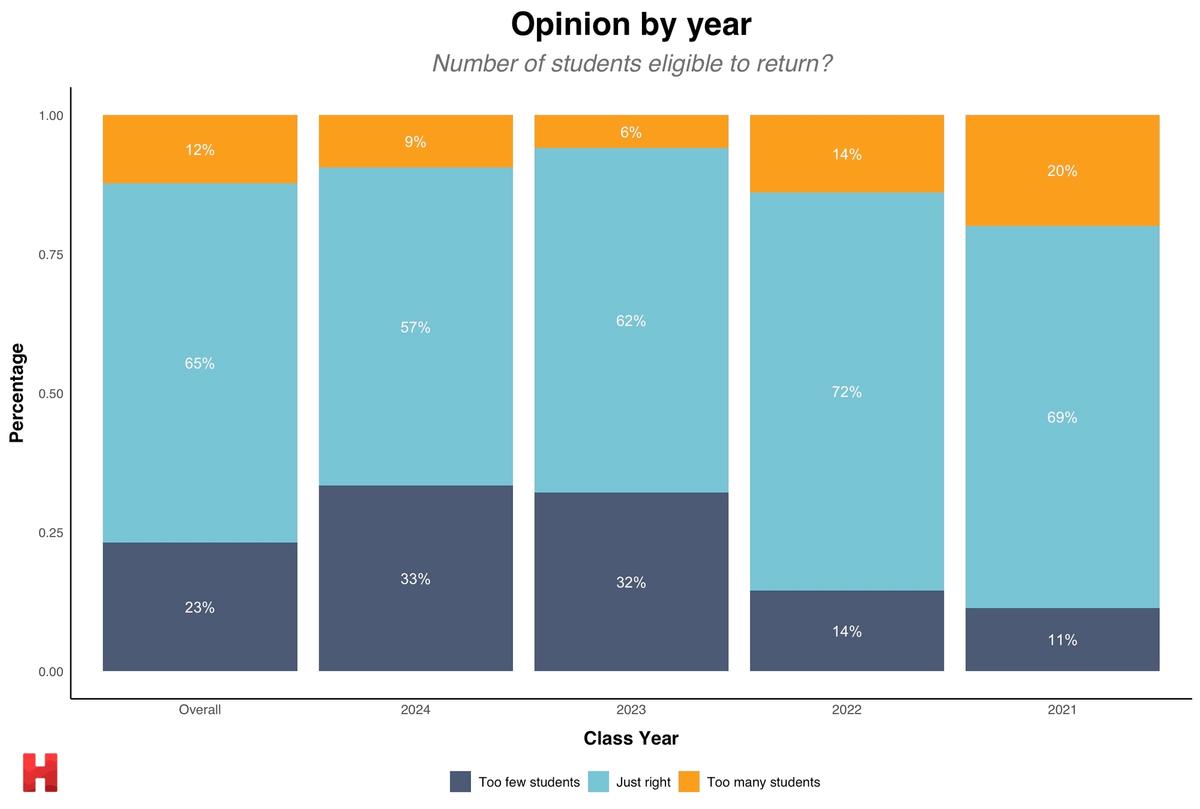
A cornerstone of the Spring plan is a community compact outlining on-campus health measures students in residence are required to abide by. Although the administration’s self-described rationale for inviting seniors and juniors to return is a “need to access campus-based academic resources,” more than a third of seniors surveyed felt “too many” measures were being taken. Limited access to physical learning spaces like classrooms, labs, and libraries, for example, remain in place through next semester.
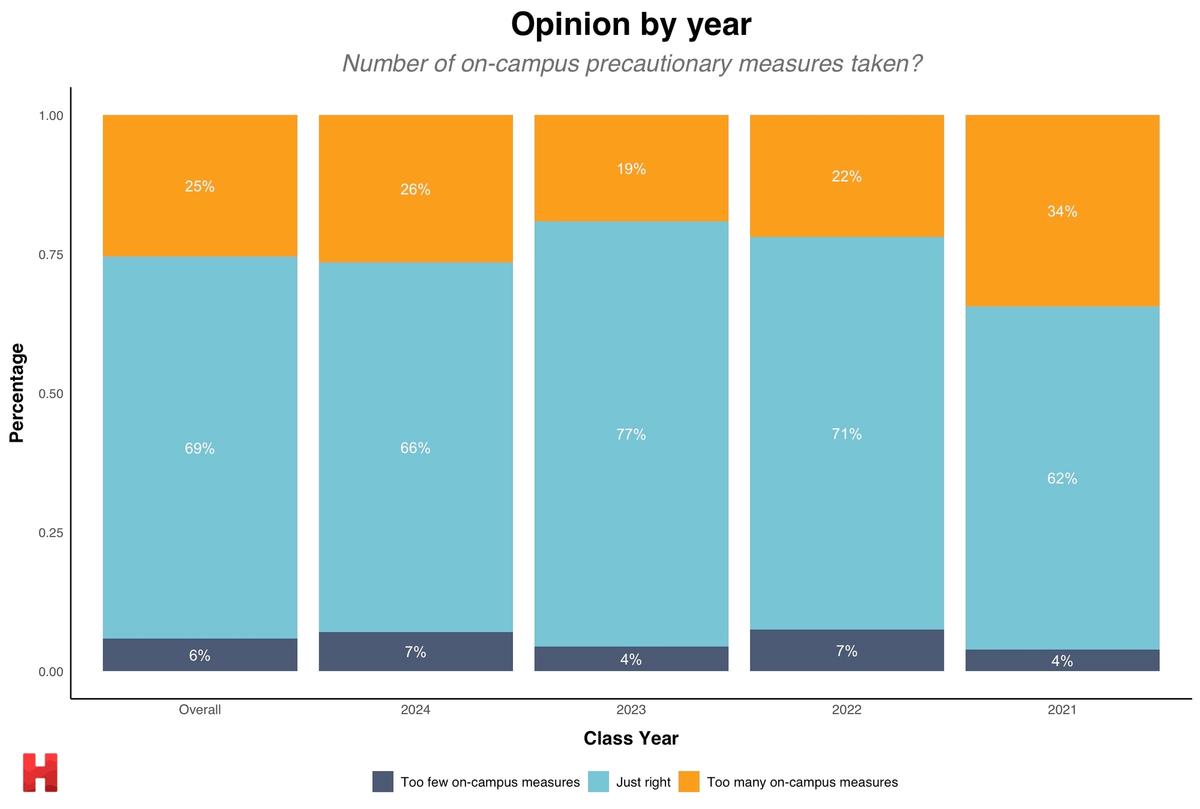
Sample Representativeness
The data analyzed here comes from a survey sent out to undergraduate students in the classes of 2021, 2022, 2023, and 2024. The survey was conducted from Dec. 6 to Dec. 8, receiving 792 responses in total. The breakdown of our respondents roughly reflect that of the Harvard student body: 53.1 percent surveyed reported being on financial aid, and 9.6 percent reported being international students, compared to 55 and 12 percent, respectively, of students overall. However, we allowed students to self-report financial aid and international status, likely under-weighting the true proportion of either populations in our sample.
The proportion of students on leave in our sample reflects the percentages reported by Harvard this fall: 25 percent of seniors, 30 percent of juniors, and 25.7 percent of sophomores surveyed reported taking a leave of absence for the Fall 2020 semester, compared to 25.2 percent, 31.6 percent, and 23 percent of each class, respectively, that did so.
First-years are slightly over-represented in our sample, comprising about 26 percent of respondents. To account for different response rates among class years, we re-weighted our data for visualizations in which we saw differences by year, such as enrollment, so that first-years accounted for a quarter. Our final data is internally anonymized to protect respondent privacy, and can be given upon request.
Final thoughts
While it may not yet be possible to invite everyone back, we would be remiss to not comment on the missed experiences, friendships, and learning that students will continue to live through this spring. For many, over a quarter of their college experience will be defined by COVID-19. Returning to campus may restore a sense of normalcy, but that normalcy will likely feel farther from normal than we would all like to imagine.
We are grateful to the hundreds of students who filled out our survey and helped us shine a little more light on the spring semester, without whom this article would not be possible. The deadline for all Harvard students to submit the Spring term confirmation form is December 14, 2020.
We hope that this analysis has helped inform and assist the Harvard community as we plan for the Spring.
